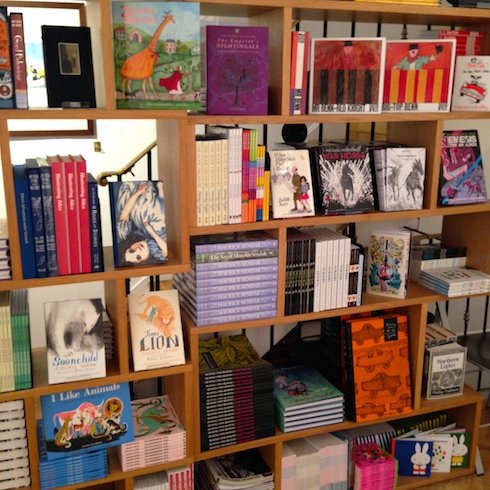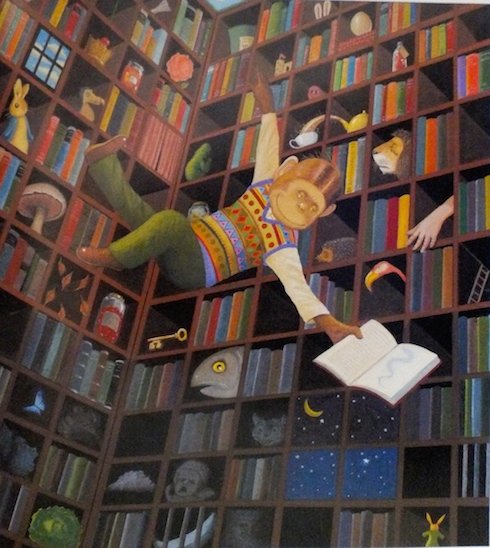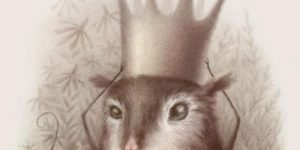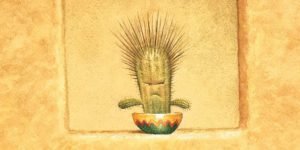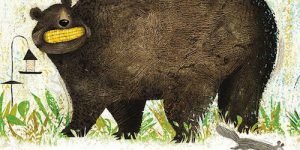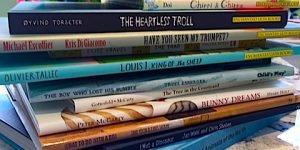I had purchased tickets in March to see Kate Bush in London September 9th, but was unable to commit to the trip until three weeks prior to the concert date. Not sure why. A lot of money, I guess, for a short trip, but in the end, I realized that if I didn’t go, I would regret it for the rest of my life. It had been 35 years since Kate had last performed, and if I had to wait another 35, we’d both be dead. So, in mid-August, I finally booked my ticket. As it turned out, I would have about a day and half to explore London. I’d visited the city on previous occasions and did not feel compelled to hit all the the touristy stops, nor did I have the time, but I did want to see if there were any illustration galleries I could visit. Edmonton is a lovely place to live, but illustration, even at the University level, is not a visible, or truly appreciated art. There are fantastic illustrators in the city, and in Alberta, but no gallery caters to illustration art. We have neither the population nor the interest. In fact, I had never been to a gallery specifically dedicated to what I consider to be the finest of all the arts – picture book illustration.
The first thing that popped up on Google was THE ILLUSTRATION CUPBOARD in central London. And, in a delightful twist of fate, the upcoming exhibit would be featuring the art of Anthony Browne – former Children’s Laureate of Great Britain, primate painter extraordinaire, and one of my all time favourite illustrators. What a crazy random happenstance! So, the Illustration Cupboard was added to my list of destinations, along with the Tower of London (to meet the Raven Master), and a bookstore, if I could find one.
In the early afternoon of September 9th, I emerged from the Green Park District Line underground and, after several missteps, detours, and many failed attempts to orient myself using a map, I found the Illustration Cupboard, located in a very picturesque area of London (St James). A very busy, and high-end area as well. The gallery is tucked into a sloping street of shops, close to Fortnum & Mason (and its provocatively displayed sweets). I knew I was in the right place when I saw Anthony Browne’s newest book, Willy’s Stories, in the window. It was tremendously exhilarating to a: have found the place, and b: stand in front of Anthony Browne’s original artwork. The title of the exhibit was 30 Years of Willy the Wimp, his frequent protagonist (and chimpanzee) who is arguably Browne’s ‘shadow’ self. It was very interesting seeing the illustrations up close – they are far more delicate and beautiful than I could have imagined. This is not to suggest that the printed illustrations are anything less than magnificent, but the originals have a virtuosity of detail that, I can see now, is impossible to reproduce. There is genius in every line, whether in a chimp’s face, or the trunk of a tree. It is also oddly cheering to see areas of white-out. Watercolour, even for the great Anthony Browne, is a bitch.
The Illustration Cupboard not only has original art, it also has the most exquisite collection of picture books, most of which have been signed; a crack house, in other words. I spent a long time in front of the Anthony Browne display but in spite of the first edition signed copies, I settled on his most recent book Willy’s Stories, which was also signed. I have most, if not all of his books at home, and as much as I would have liked to purchase ALL of the signed first editions, I just couldn’t. My addiction, thus far, is manageable, but given the right circumstances (robbing a bank), I could imagine spending many thousands of pounds in this gallery, starting with a certain chimp.
In addition to the Browne, I picked up a signed edition of The Selfish Giant by Oscar Wilde (Hutchinson, 2013), with illustrations by Alexis Deacon – an illustrator I’d never heard of, but fell in love with on the spot. Also, The Wonderful Egg by Dahlov Ipcar (Flying Eye Books, 2014). It’s a reissue of a book originally published in 1958. What can I say, I have a soft spot for vintage illustration, and the Ipcar  book has the most wonderful dinosaurs!
book has the most wonderful dinosaurs!
There were many temptations at The Illustration Cupboard, including a selection of very beautiful limited edition books, in particular Through the Looking Glass, with illustrations by John Vernon Lord, but time was ticking, and I wasn’t at all certain that I could find my way back to the Green Park Underground. Turns out, I was right, ending up on embassy row, but a kindly man in a guard’s uniform came to my rescue, and I was soon on my way back to Hammersmith. My directional challenges were no fault of the Illustration Cupboard – the location being quite straightforward (once I found it). For reasons beyond my comprehension, I enjoy a certain, shall we say, mental distance from maps and logic, and at no point during my stay in London did I have a single clue as to where I was, or what direction I was facing.
It was several days (and many, many hours in airports) before I read through Willy’s Stories, which is a companion of sorts to Willy’s Pictures, published a few years ago. In Willy’s Pictures, Willy introduces the reader to his favourite works of art. In Willy’s Stories, it is great literature that inspires the affable chimp, and it begins with a trip to the library ~
“Every time I walk through these doors something incredible happens. I go on amazing adventures.”
Yes, and that’s just how I feel every time I open a new Anthony Browne book.
Reading, for Willy, is a full-immersion sport. One day he is Peter Pan, sword fighting with Captain Hook on the deck of a ship. Another day he’s a character in Alice in Wonderland, falling down a book-lined rabbit hole. As these classic children’s stories inspire Willy, so do they inspire Browne to create some of his most beautiful work to date. Typically, an Anthony Browne illustration is awash in bright colour, a counterbalance to the muted monkey-browns of Willy and his primate kin. Occasionally, however, Browne goes full on, fairy-tale dark, as in the painting that accompanies Willy’s description of a scene from the Wild Wood in The Wind in the Willows. The ghostly spectre of a fantastically gnarled tree sits in the middle of the page, every branch scarred by half-formed creatures. Eyes stare out from the murk while Willy, almost invisible in the autumnal colours of the forest floor, hides in a hollow at the base of the tree, terrified. Who knew Wind in the Willows could be so creepy, or inspire such dark imagery? There is nothing wimpy about that chimp’s imagination! And yet, in spite of the spookiness, Browne’s masterful illustration retains his signature playfulness in the humourously camouflaged details, like the row of books tucked into a hollow of the tree. In fact, books are present in every illustration in Willy’s Pictures (much like the bananas that have so often made appearances in previous books). As always, nothing is quite what it seems.
As gobsmackingly wonderful as it was to see Kate Bush in concert, the opportunity to see Anthony Browne’s original artwork was, in its own way, equally exhilarating, and inspiring. My deepest gratitude to the Illustration Gallery for having the foresight to run this show while I was in London. So kind of them! And of course, for their continued celebration and promotion of great illustration and illustrators. My only regret is that I couldn’t stay a longer. The current show (Sept 24 to Oct 18) is The Art of Shaun Tan, another one of my absolute faves. Ah well…
 WILLY’S STORIES by Anthony Browne, published by Walker Books, 2014
WILLY’S STORIES by Anthony Browne, published by Walker Books, 2014
Other Anthony Browne reviews:
For more exciting stories about my adventures in London, read THIS.




